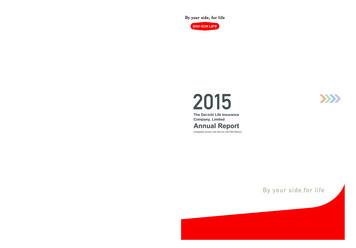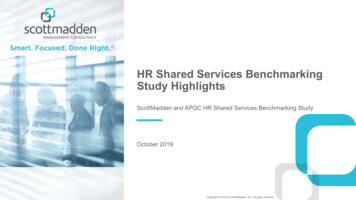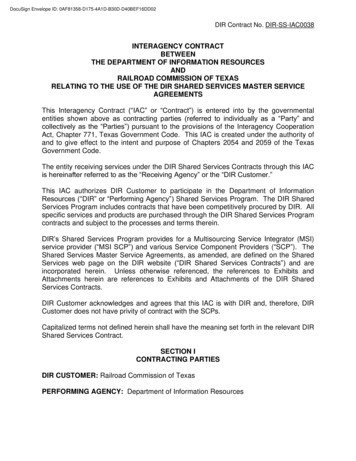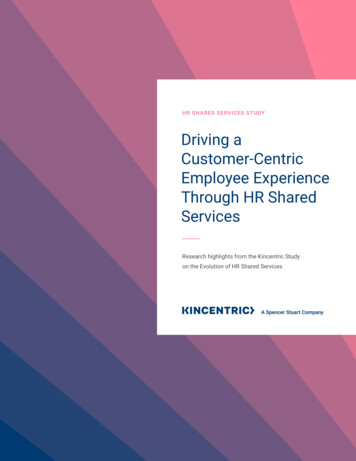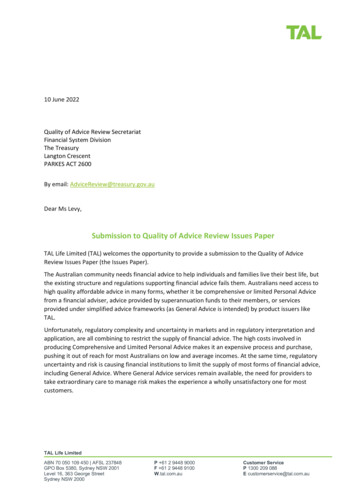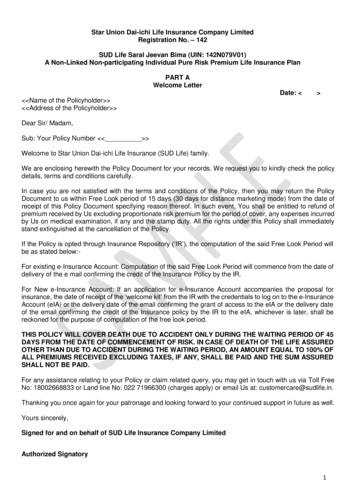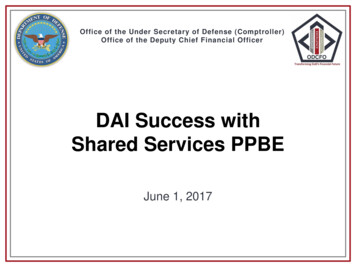
Transcription
Office of the Under Secretary of Defense (Comptroller)Office of the Deputy Chief Financial OfficerDAI Success withShared Services PPBEJune 1, 2017
2
OUSD(C) Business Integration Office (BIO)BIO’s Mission StatementDoD Financial Management community lead for creating and sustainingmodern, effective, and cost conscience financial managementprocesses, data, systems, policies, and work-force. 5.2 Billion2702,000 Cost of FM Line of BusinessFM IT SystemsPoint to Point Interfaces3
BIO’s Alignment to DoD FM Vision & GoalsDoD’s FM VisionTo achieve a DoD FM environment that is standard,simplified, affordable, auditable and secureGOAL 1 – Achieve auditreadiness and sustain anauditable businessenvironmentBIO GOAL 2 – Enhance andimplement financial policiesand processes to improve,standardize, and simplify theFM business and systemsenvironmentGOAL 3 – Develop andmaintain a well-trainedfinancial workforce thathas the knowledge, skills,and abilities to providedecision support andanalysis as well as achieveand sustain an auditablebusiness environment GOAL 4 – Develop astandardized PPBEprocess that enables endto-end (E2E) fundstraceability and datalinkage between planning,budgeting, and execution BIO’s mission best aligns with Goal 24
FM Strategy Framework ImprovedDecision Making and Business Outcomes OMB A-123FISCAMSSAE-16MICPOMB A-136FFMIA P2PSFISUSSGLIGT SV-8 (reduce legacy systems)ERPsGEXData standards improve decision making, informationreliability, and make for a more interoperable environment5
Agenda DAI Overview Implementation of DAI PPBE and DAI6
Problem Statement FY 2008 NDAA, 110th CongressCongress has consistently criticized DoD forits inability to produce auditable financialstatements - the largest Federal Agency unable to produceauditable statements DAI supports two major solutions for auditreadiness:–Financial Improvement and Audit Readiness (FIAR) – drivesprocess standardization, creation of internal controls, and a supportframework that is system agnostic–Enterprise Resource Planning (ERP) Systems – drive integratedfinancial management processes and deliver full visibility to financialdata, with key reporting and reconciliation tools to support auditsSec. 1005. FINANCIAL MANAGEMENTTRANSFORMATION INITIATIVE FOR THEDEFENSE AGENCIES(b) Purposes – The purpose of the initiative shallbe as follows.(1) To eliminate or replace financialmanagement systems of the DefenseAgencies that are duplicative, redundant, orfail to comply with the standards set forth insubsection (d).(2) To transform the budget, finance, andaccounting operations of the DefenseAgencies to enable the Defense Agencies toachieve accurate and reliable financialinformation needed to support financialaccountability and effective and efficientmanagement decisions.Mission:To transform the budget, finance, and accounting operations of the Defense Agencies toachieve accurate and reliable financial information in support of financial accountabilityand effective and efficient decision making throughout the Defense Agencies in supportof the missions of the warfighter. Common business processes are: procure to pay; orderto cash; acquire to retire; budget to report; cost accounting; time and labor. Fulldeployment capability will include budget formulation; grants financial management; andre-sale accounting.7
DAI Strategic Alignment Capability Heat MapStrategic InitiativeCapabilitiesNext StepUniverse ofTransactions 98% of DAI general ledger details are reconciled tothe Unadjusted Trial Balance Feeder recons and financial statement reconsavailable Automate the QDD as interface that canbe sent via GEXFBWT – CashAccountability Deployed USU on direct treasury disbursing (DTD) Schedule remaining Agencies to DTD Foreign currency DTD will be availablesummer timeframeSFIS/SLOA/USSGLCompliance DAI is over 95% compliant with SFIS/USSGL SLOA complaint (P2P and O2C) Finish JITC assessment and reviewresults for any SCRsProperty Implemented DPAS at 5 Agencies Tririga implementation Review future capability needs (e.g.calculate depreciation in DAI)Audit/IT Controls DAI received a qualified SSAE-16 opinion with lowrisk findings Implemented GRC Continue audits Further roll out GRC capabilitiesJournal Vouchers 3% of journal vouchers input into DAI Tracking recommendations from JVworking groupCost Management Implemented cost management structure for all DAIagencies DCMO is creating cost managementframework. May impact DAI AgenciesPPBE Standards Implemented P2P handshakes 1, 3, 4, 7 & 8 Implemented budget formulation at DSS and DCMA Further capabilities around additionalappropriations and exhibits Deploy additional AgenciesFunds Distribution Complies with USSGL funds distribution posting logic EFDAlignedModerately AlignedNot Aligned8
DAI CapabilitiesCost Management (CM) (Cost Accounting)Legend:BEA E2E Business ProcessesIncrement 2 Business ProcessesDelivered capabilitiesIncrement 2 capabilitiesOrder to Cash (O2C) Collection of all costs such as: Activity Based Cost, Job OrderNumber, Process costs and Standard costs Allocation of indirect costs DWCF Update general ledger Update reportsEnter funds from TreasuryAllocate funds to organizationsDWFCUpdate general ledgerUpdate reportsCostAccountingBudgettoReportBudget Formulation(additional B2R processcapabilities) Develop budget for out year andPOM Support forecasting, and “whatif” scenarios Generate required documentsBudgetFormulationProposal to Reward (P2R) (Grants Financial Management)Award a GrantApportion and allotment fundingTrack and close grantOversight and al FundWorkingCapabilityand CapitalofDefense WorkingRevolvingCapital anagementRe-Sales Accounting (DeCA Unique) Set up agreementsCollect cost and calculate billDWCFBilling and collectionUpdate general ledgerUpdate reportsProcure to Pay (P2P)Budget to Report (B2R) Non-Appropriated Fund FFMIA requirementsPerform accounting for the DECA inventory and any otherAgencies that have inventory for saleRe-saleAccountingTime&LaborProcuretoPay Create commitmentCreate obligationPerform receipt & acceptanceDWCFUpdate general ledgerUpdate reportsAdvanced Procurement SystemContract Lifecycle ManagementDirect Treasury DisbursingAcquire to Retire (A2R)AcquiretoRetire Define assetDetermine in service dateDetermine depreciationUpdate general ledgerCIP ReportingUpdate reportsRetirement of assetHire to Retire (H2R) (Time and Labor only) Automated individual or timekeeper inputinto system Time allocation for Cost Accounting purposes Automatic generation of time cards Automated Absence Management9
Agenda DAI Overview Implementation of DAI PPBE and DAI10
We have come a long way!11
12
DAI – Shared Service Provider13
DAI User Growth326Users40,000 UsersDeployed to 20 Agencies14
Providing Value15
DAI Business Case CapabilitiesBusiness Case Gets Realized When Everyone Starts Using the Full Suiteof EADirect TreasuryDisbursingDCMADSCAMDAScheduledNot GDOT&EDPAADSCADSSMDAOEA16
BPR Process for DAI(Inc 1, R3.0 Example)17
DAI Success Factors18
Agenda DAI Overview Implementation of DAI PPBE and DAI19
PPBE Problem Statement Disparate technology used across each agency to include COTS,Excel, and custom development–Significant costs to support system (IT, O&M, Training, etc.)–Agencies working repeated effort to integrate DAI actuals into individual systems–Staff need to learn new technology as they move positions Agencies have varying capabilities based on investment–POM/BES/PB–Spend Planning–Revolving Fund Agencies performing similar functions using different methods–Civilian Pay Planning and Forecasting–RMDs and Issues–Exhibits and Reporting Limitations on extending to larger user base due to capabilities20
PPBE Solution Benefits Alignment of Programming and Budgeting with ExecutionMaster Data Structure & Actuals Integrated from DAI Financials Drives alignment of master data structures to support POM/Budgetand not just execution. Direct actuals integration aligns budget with actuals. Reduces costs for needing to perform time-consuming data work totranslate DAI data into legacy systems and then validate. Establishment of Common Business PracticesAgency stakeholders work together to establish best practicesGlobal model concept provides common baseline for each agency Single technical platform but segmented by agency to supportflexibility in processes and securityCommon mappings of DAI master data to OSD structures21
PPBE Solution Benefits (Cont.) Full set of PPBE capabilities available every agency– Agencies can chose from a list of capabilities POM Issues, Budget, SpendPlan, reports and exhibits.Single Technical Commercial Software Solution–––Out-of-the-box capabilities speed delivery of capability MS Office Integration, What-if Analysis, Planning Forms, & Reporting Pilot capability delivered within the 1st year of PPBE Work-streamSolution reduces training and development costs MS Office interface brings quick adoption Ability to produce reports and templates reduces reportingdevelopment and drives reporting management to the agency.Significant IT cost reduction over individual agency systems Leverages DAI platform for hosting, maintenance, and support Removes the need for independent systems and associated costs.22
Agency Feedback on Improved Capabilities1. DAI integration of actuals and structure Plan, forecast, and manage PPBE using DAI structures Provides ability to adjust to match 1002 reports and use actuals for exhibits. Ability to run OP-32, CIS Code, and other views on budget during build.2. Common menu of capabilities for all agencies Existing agencies had only a subset of capabilities and now have ability toleverage all components (e.g. some agencies only have Budget or SP today)3. Brings strong capabilities over using MS Excel manual build Repository where everyone can tap into instead of trying to find the lastversion of the spreadsheet. Helps small agencies that would not be able toinvest in a system. Allows for user expansion driving PPBE planning to a more granular level.4. Strong technical capabilities MS Office integration, user-friendly interface, what-if scenarios, etc.23
Lessons Learned DAI SMEs were key to understanding data structures– Reviewed lessons learned from other implementations– Applied USSOCOM techniques to accelerated delivery of DAI capabilitiesIdentified wide variation in agency PPBE business practices––––– Master data alignments and actuals integrationAgencies with more labor vs investment plan detail accordinglySpend plans with/without actualsAlignment of organizations and security requirementsUse of master data structures in DAI FinancialsUtilized stakeholder agency updates to have SMEs present and bridge gapsAgency SMEs commonly burdened by agency tasking–Established weekly meetings with each agency and worked aroundschedules24
DAI PPBE Capability Overview25
Oracle Hyperion (PPBE Software)26
Status of Deployments & Capabilities PPBE (Budget Formulation) is New to DAI– R3.0 Initial Release Completed in 1 year (2016) BES/PB Build & Spend Plan Build– R4.0 Release to be Deployed in 1 year (2017) POM (Issues Process), Rent Estimation, Additional Appropriations,Reports and Exhibits– Multiple Agencies Requesting R4.0 Onboarding: DAUDPAADCAADHRADODEA27
PPBE Release Snapshot28
R3.0 (Pilot): Establishing Global Model Developed from agency workshops, questionnaires, and pilot prototypes Standard modeling of core data structure– Agencies have flexibility to model business using the DAI Financials hierarchies– Budget elements to support submission requirements and aggregated planning Standardization of Core Mappings– OSD Line Code to Object Class with Labor Category– Standard loading OSD Line inflation rates– OP-8 Mapping Actuals Integration (Monthly)– Sub-ledger Obligations, Commitments, and Expenditures– GL Adjustments Multiple Scenarios– Cycle Snapshots and What-if Drills– Actuals and 1002 Adjustments29
R3.0 (Pilot) Capabilities Global Model Foundation BES/PB Capability (Inputs & RMDs)– Detailed Civilian Pay Costing Module & Options (Gains, Losses, & Transfers)– RMD tracking, Global reductions and additions, and multiple scenarios– OP-32 Price and Program Growth Calculations and exporting Spend Planning Capability––––Ability to execute a spend plan with or without DAI Actuals integrationAllows for monthly forecasting of labor and expensesSupports detailed planning to wide user-baseAverage Annual Rate metrics Agencies Deployed: DCMA & DSS30
Release 4.0 Capabilities R4.0 Capabilities added to R3.0 Baseline: POM (Issues & Zero Sum Transfers)– Extension and inflation.– Delta-based planning capability to support 1 – N list Issues and ZSTs– Issue acceptance and rejection.– Capability to develop reports to support ICT briefings and roundtables Revolving Fund Capability– Development of rent estimation model with rate calculations BES/PB Additional Capabilities– Civilian Authorizations and Contractor Personnel Tracking– Expansion of Fiscal Guidance controls– Allotment Accounts– Management reports and additional exhibits Agencies Deployed: WHS & OSD31
DAI PPBE Onboarding Process32
Activities for Onboarding33
Hyperion Capability Onboarding Schedule34
Problem Statement 7 Congress has consistently criticized DoD for its inability to produce auditable financial statements - the largest Federal Agency unable to produce auditable statements DAI supports two major solutions for audit readiness: - Financial Improvement and Audit Readiness (FIAR) -drives process standardization, creation of internal controls, and a support
